The Box and Goodies -
The box for the CMStorm Trigger was a little more interesting than the ones for the QuickFire series or even the Tt eSports keyboards we have played with this far. You have a small open window that shows you what the style of the keys are inside of a larger graphic of the actual keyboard. The front lists three very important features of the Trigger; the Cherry MX switches (the model we tested had Cherry MX Brown), the 64KB of memory for your macros and profiles, and of course the 5 fully programmable keys that you have to tinker with. 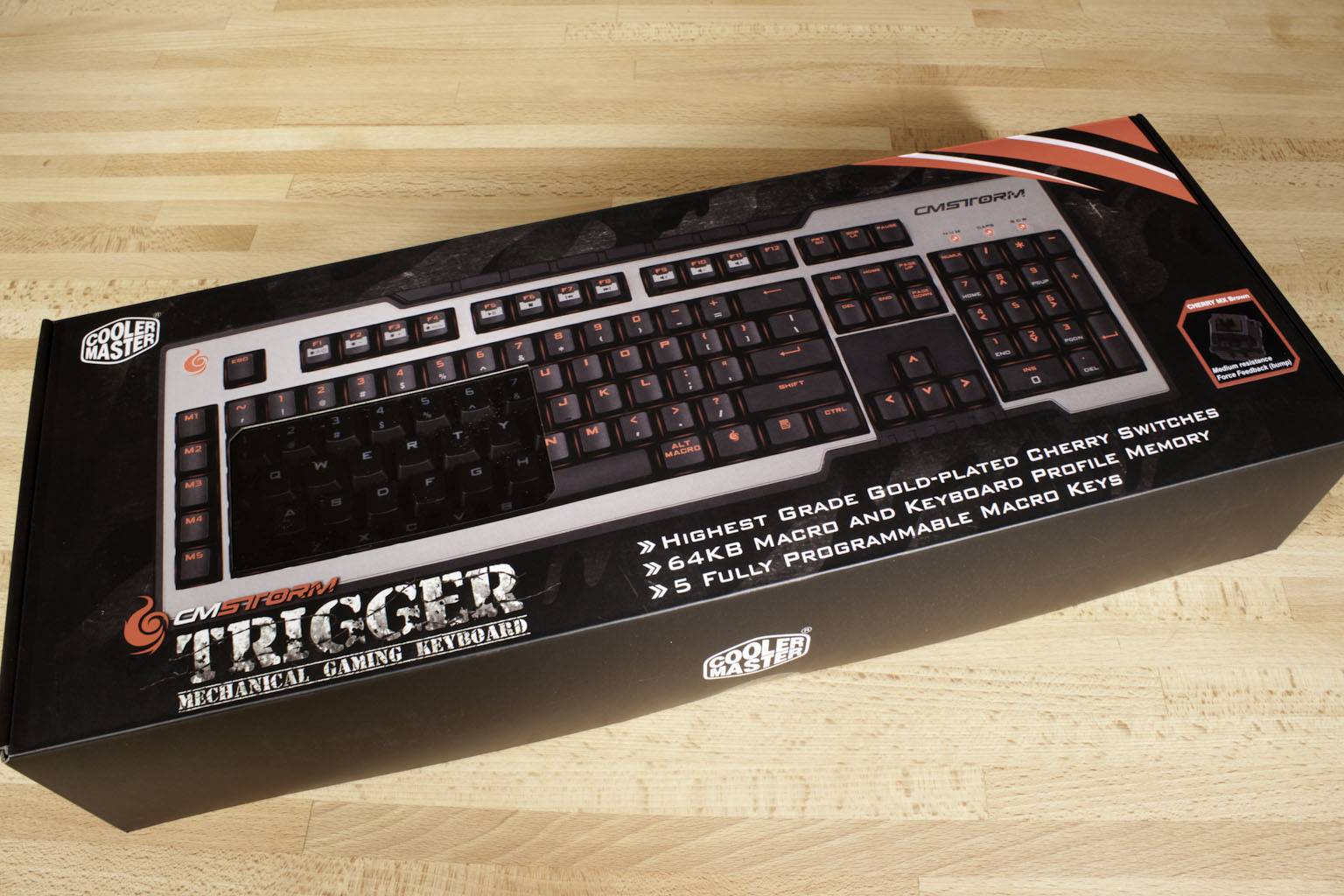
The top of the box shows off a few more things that are of interest; like the powered USB hub on the back. Unfortunately the 5V power pack needed to add the power is not included. You can still use these two ports, but there are comments saying that plugging in a USB device can kick the keyboard offline.
 |
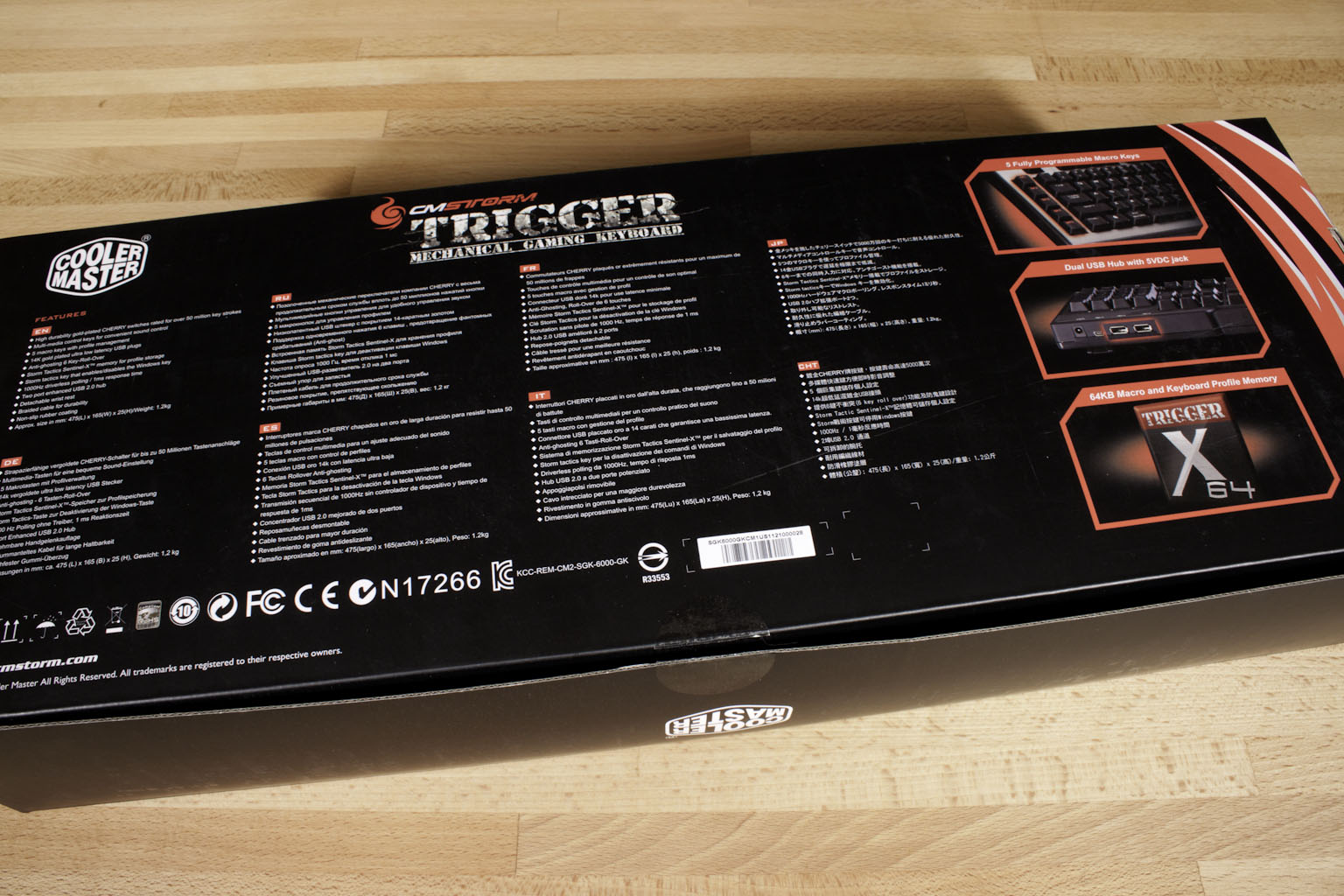 |
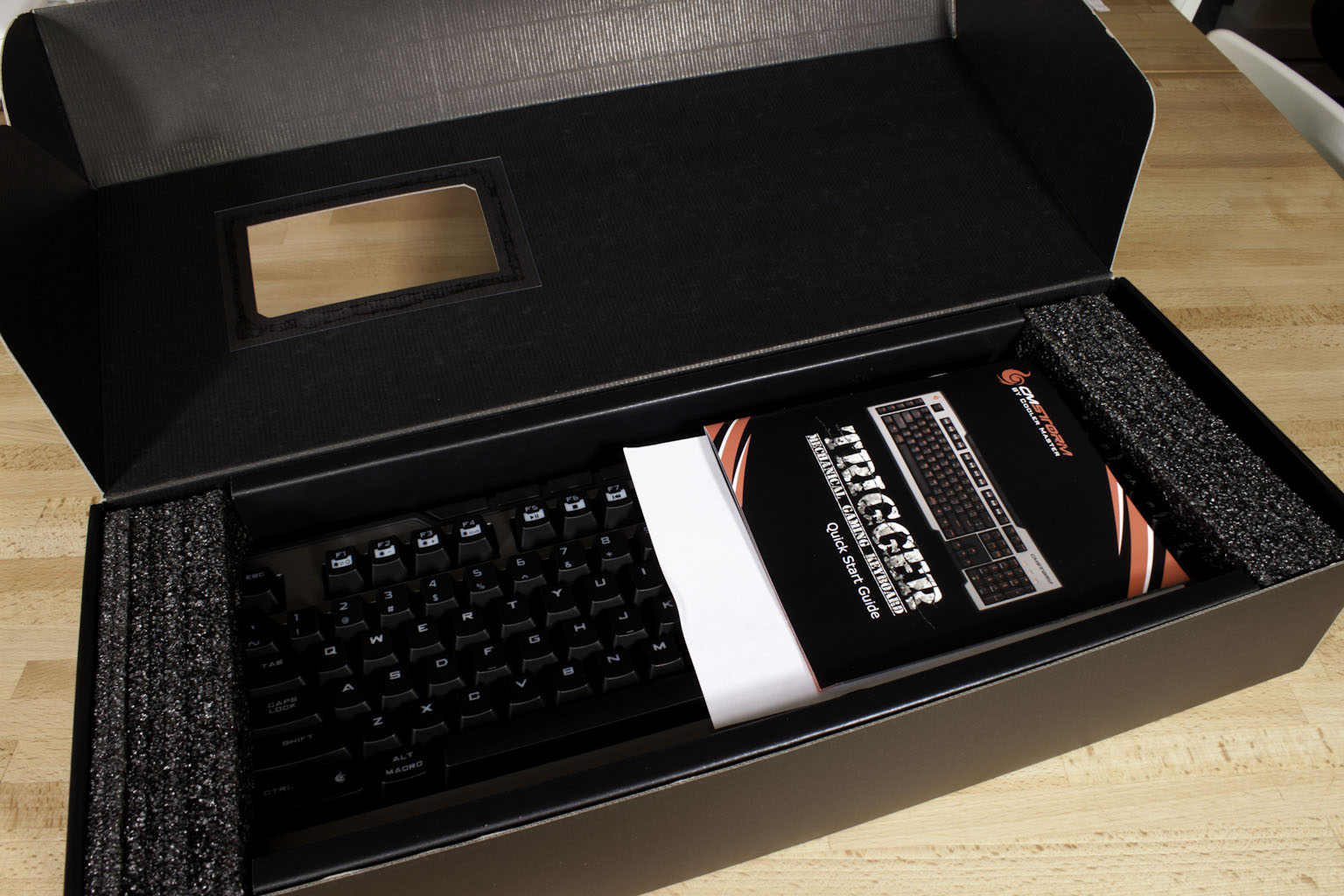 |
The back of the box has,… well not really more detail, but it does show off some of the features a little better than what it is on the front or the top of the box. Still the box is not what you can to read about. So let’s take a look at what is actually inside the box. When you first open the box you can see the Trigger sitting underneath the quick start guide. As with the Sentinel II Advance, there is no driver/utility CD. There is a note that you can download the software from CMStorm.com (we will cover the software below). Along with the guide, keyboard and wrist rest you get a braided USB cable that has gold plated ends (this is mostly for show as plating the ends with gold has an exceptionally minor effect on performance).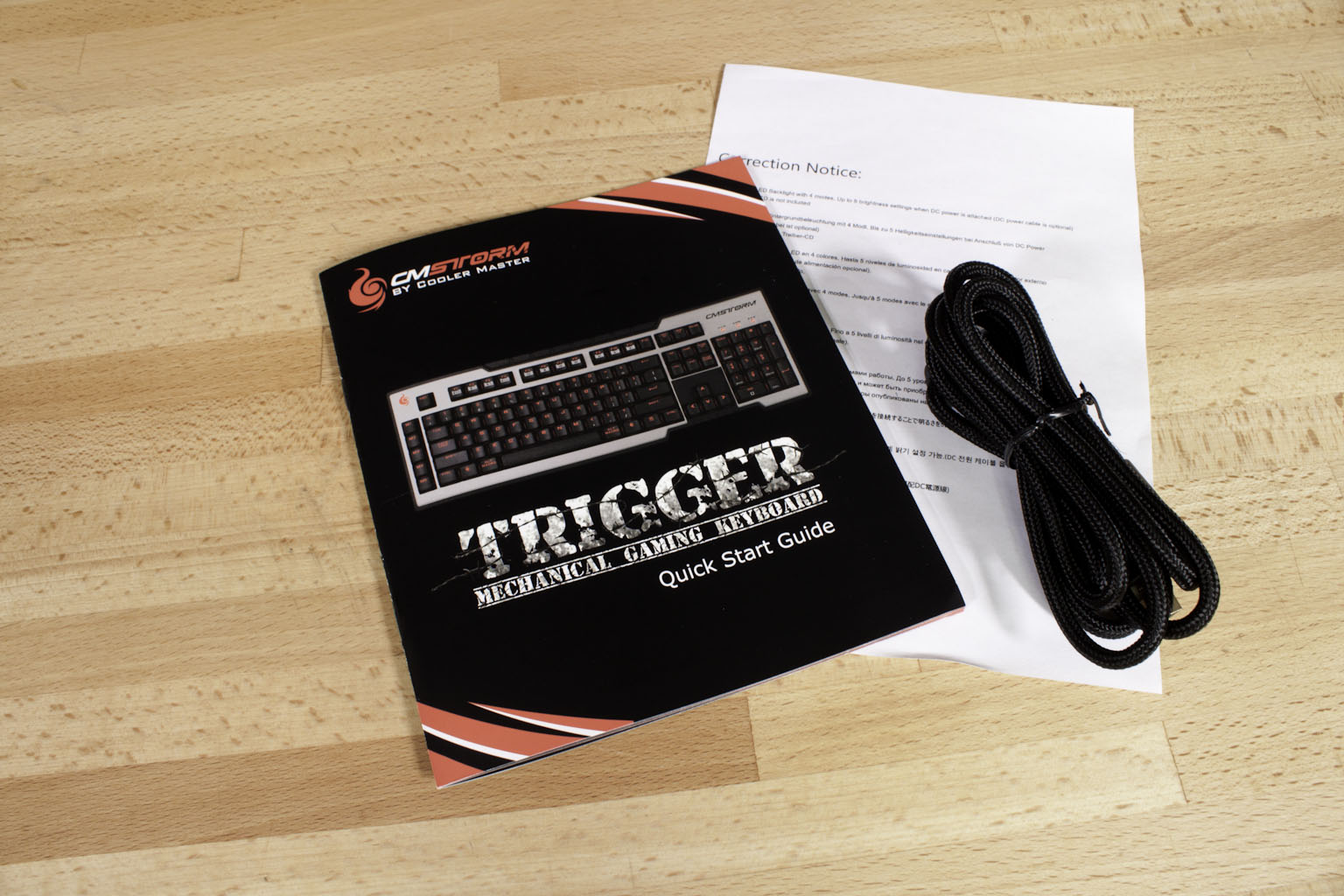
The CMStorm Trigger Gaming Keyboard -
The Cooler Master CMStorm Trigger is fairly heavy like most other gaming keyboards. This is to help keep the keyboard stable while you are pounding away on it during you8r gaming sessions. It is a full keyboard with number pad and, as you saw on the box, has a row of macro keys (5 keys to be exact). 
The styling is interesting as they have given the back a little indentation with grooves (I guess to make it more interesting to look at) and a real indentation at the front right below the arrow keys. This actually gives it a less box look than some of the other keyboards we have tested. To add to the differences in styling the Trigger does not have the same wedge look that the QuickFire keyboards did. There is a slight rise towards the back but it is not as pronounced. Under the Trigger are some very large rubber pads that when combined with the weight makes the Trigger very sturdy. The keys and the wrist rest have a slightly tacky feel to them to help keep your fingers (and hands) in place.
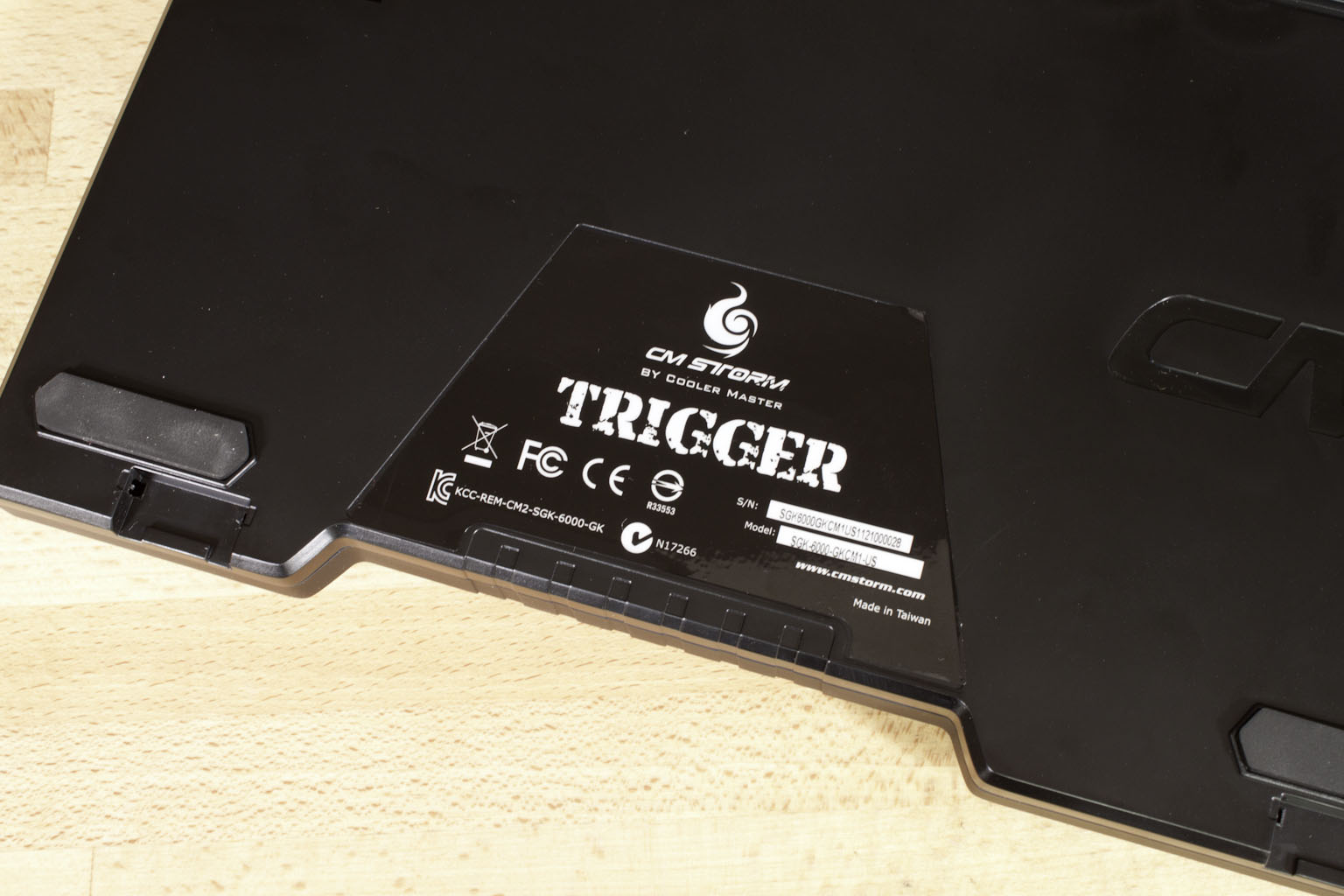 |
 |
The key clusters are the same as a normal keyboard with the exception of the macros and the lack of a real “Windows” key. Here we have the same Storm key that you saw on the QuickFire Pro except that with the software you can actually program this for a few different functions. There is also an Alt/Marco key that allows you to activate different macros that you have setup on the Trigger that might be outside the programmable keys. You will also notice that the F-Keys also serve to perform other functions like controlling the back lighting and multi-media functions (as you will see in our video coverage).
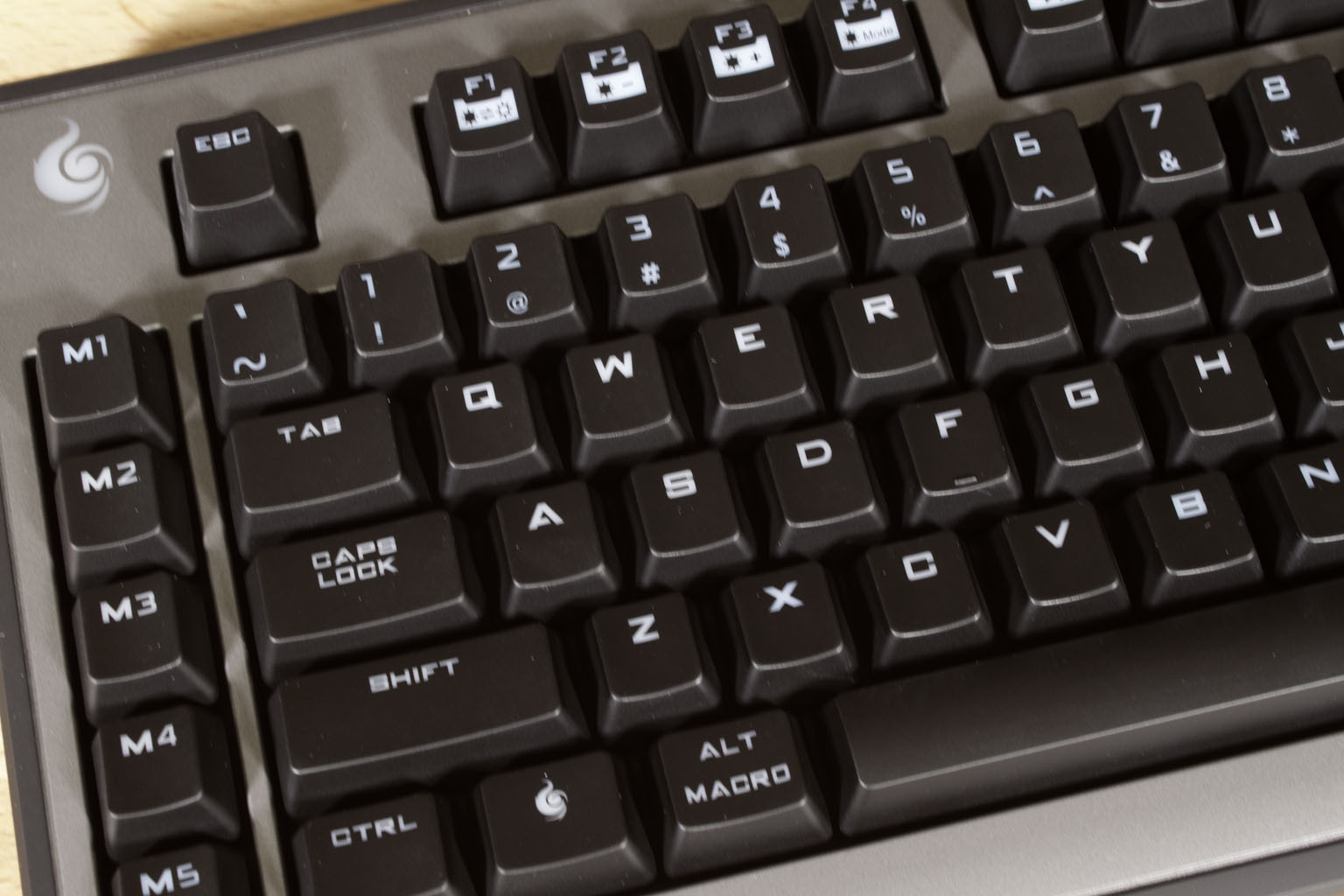 |
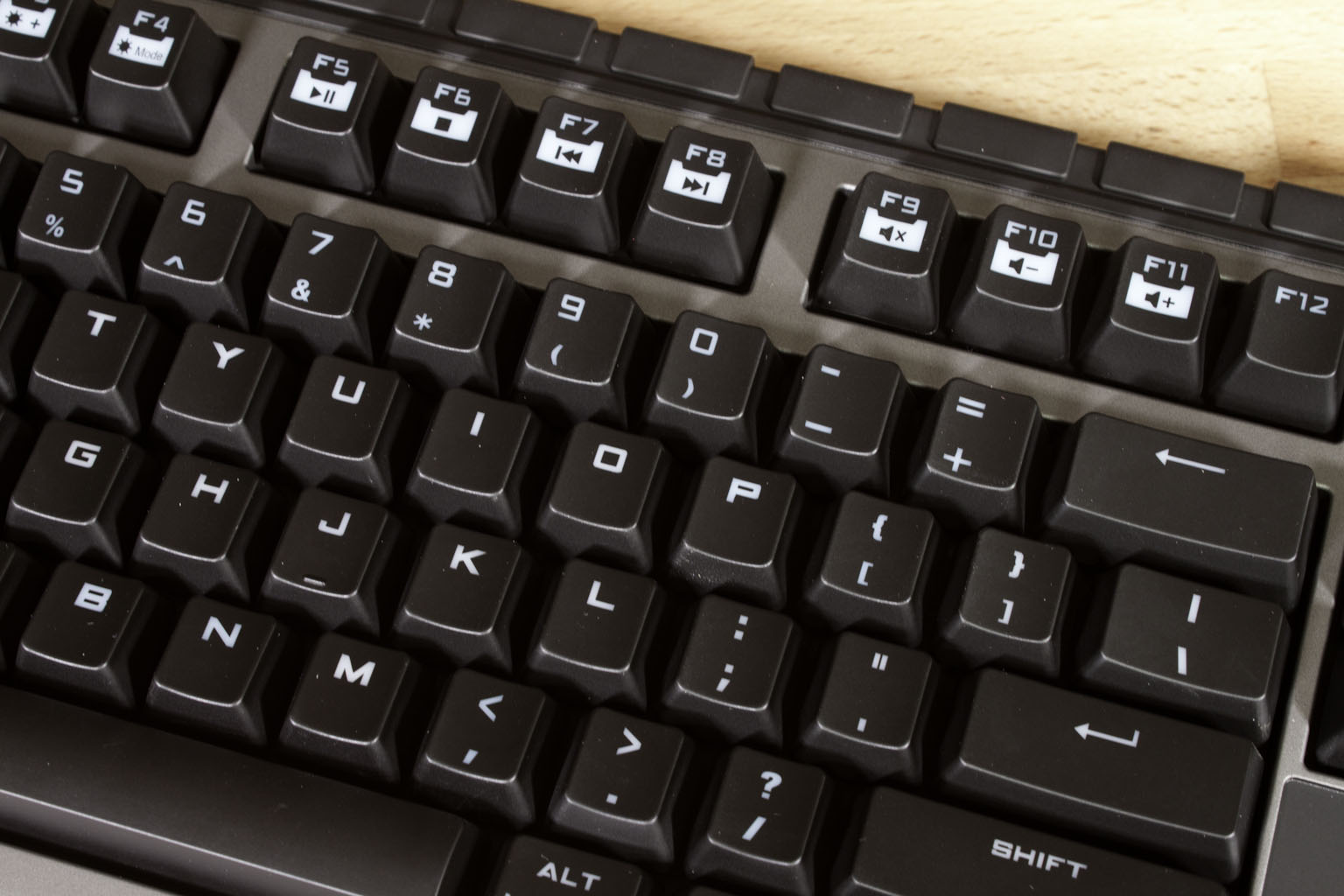 |
Along the back of the Trigger we find that 2-port UDB Hub that we talked about before. However, unless you have power, these are probably not going to get much use and many USB devices (like external drives and some thumb drives) could pull too much power and disconnect the Trigger from your system. We feel that the power cable should have been included or the keyboard should use a dual USB cable to provide data and power.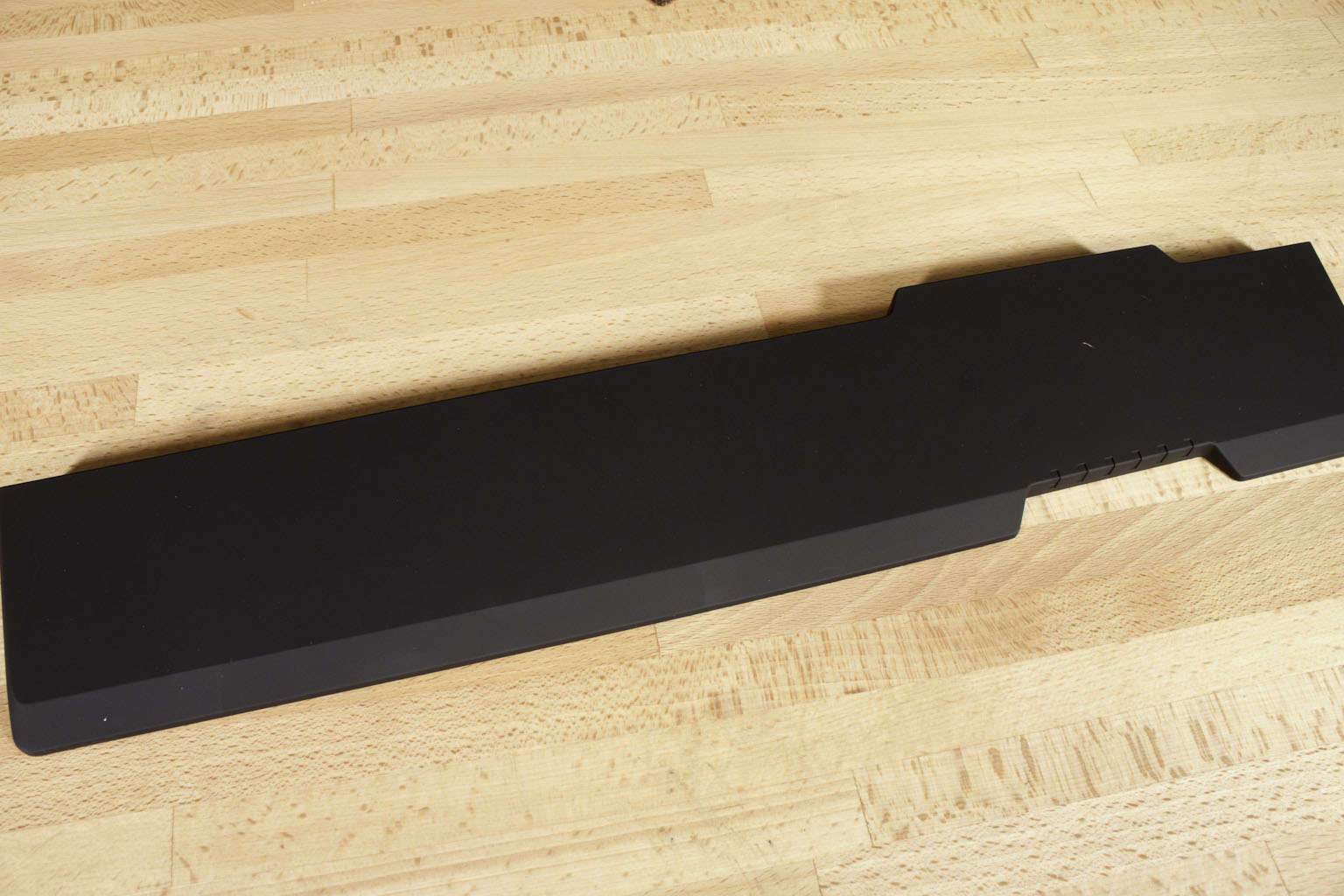
Internally the Trigger is a pretty nice device. As we mentioned before the Trigger uses Cherry MX Brown switches (although you can get the Trigger with Blue, Black or Red as well) that are rated at over 50 Million presses. This all on its own would be nice, but you still get more. The Trigger has up to a 1000Hz polling rate making it very responsive as long as your USB port supports that. You also have 6-Key rollover in USB mode which is a handy little feature, but we wish it had the full N-Key like the QuickFire Pro did. The trigger also has full backlighting on all of the keys and includes three modes of operation (Cooler Master says four, but off is not a mode to us). We show off each of these in our video coverage of the Trigger below.
The Trigger App -
The Trigger’s control App can be downloaded from the CMStorm website. From there it is very simple to get it installed and running. Thanks to the 64KB of onboard memory you do not have to install this software on every computer you will be using the Trigger on. You can simply setup your profiles and store them on the onboard memory and you are all set (you have options for five different profiles). 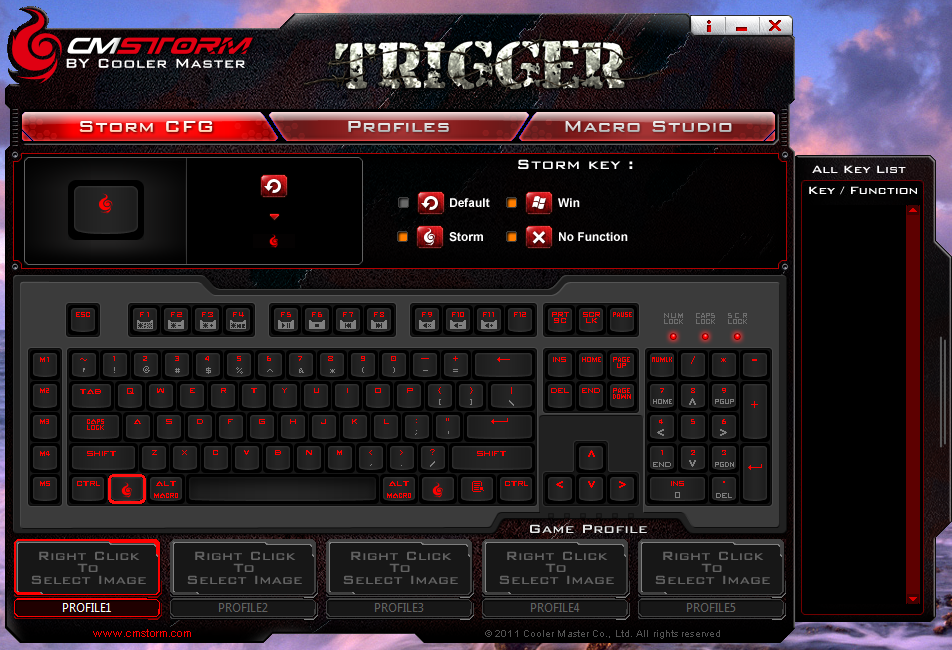
Each of these profiles is very customizable. You can set a profile to launch when you start up a certain application, move its place in the lineup and even add a logo to each profile to make them stand out more.
 |
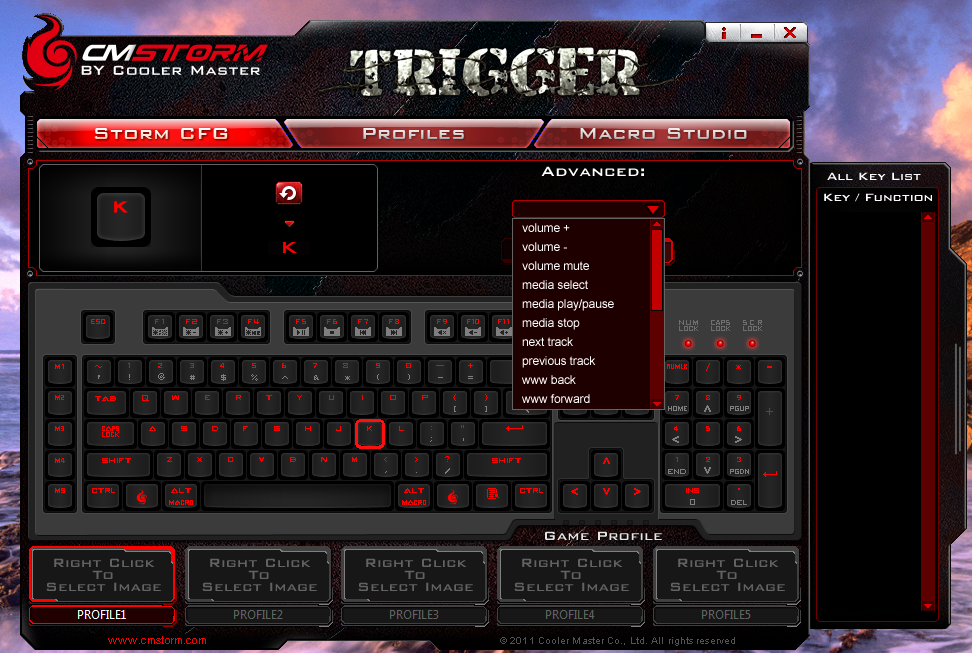 |
The option to assign an application to a profile is nice if you have custom keyboard layouts you want to use with certain games or applications (like Photoshop). This is a nice little feature and the added bonus of auto launching profiles with applications is great. You can also manually switch between your profiles by pressing the Storm key and the numbers 1-5 (each one represents a profile). 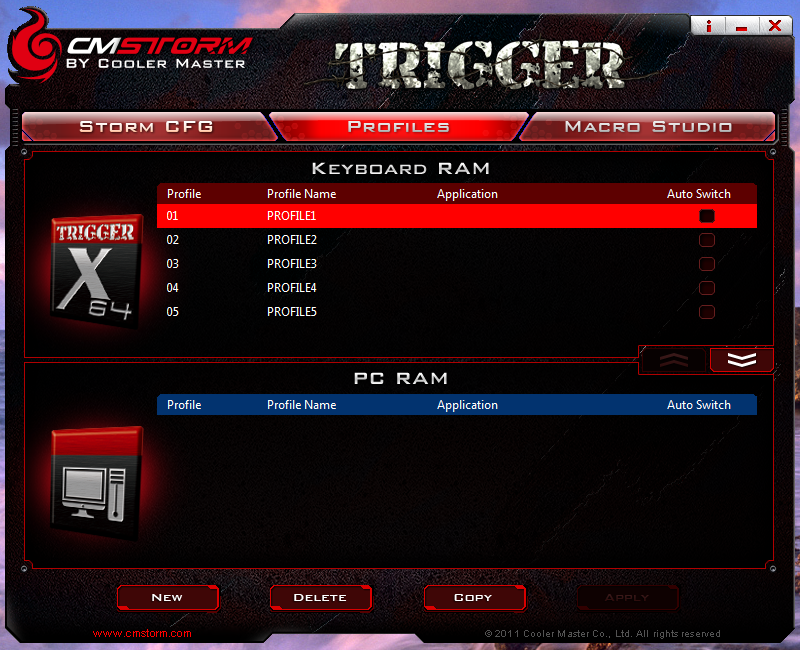
As we just mentioned being able to change the keyboard to suit an application we will take a look at the Trigger’s ability to manually remap keys. You can, for example, change the F key to type the letter Z if you wanted. You can also assign a macro to it or another advanced function, or even disable the key completely (it really is a fully programmable keyboard). 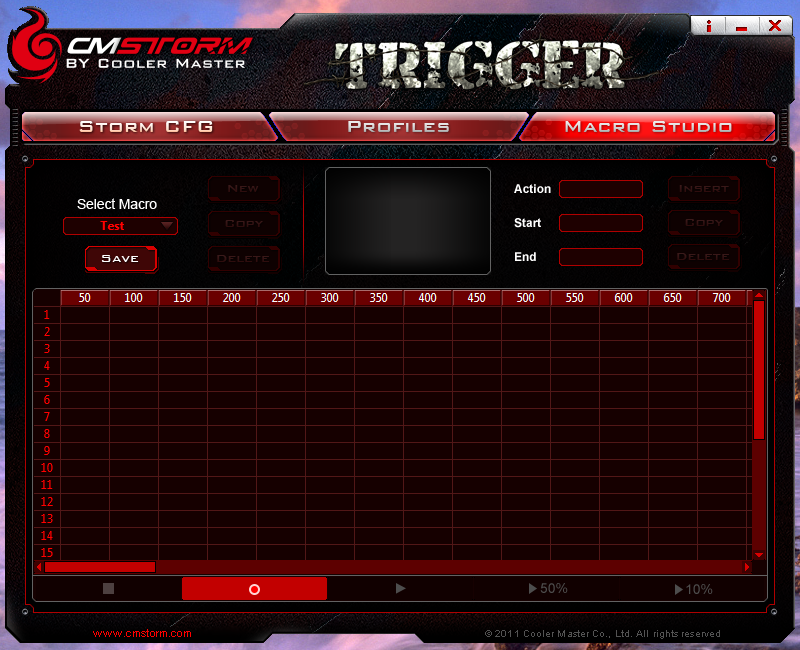
Outside of programmable keys and profiles you can also build some very complex macros using the Macro Studio. You simply click on the new button, give it a name and start recording the macro. There are three recoding modes. The first called 1:1 remembers the actual delay time between key presses, the second called Speed Mode shortens them all to a predefined number of milliseconds (the default is 50) and the last one called God Mode removes all delays making the key presses appear one after the other. 
You can also manually edit your macros using the macro studio as well. Cooler Master actually has a great series of videos on how to record, assign and edit macros on the Trigger. We highly recommend checking it out if you are getting this keyboard.
Performance -
We put the CM Storm Trigger through about 10 hours of gaming. This was with a variety of games from Alan Wake to Mass Effect 3 and through some older (but no less fun) games like Bioshock 2 and HalfLife 2. In addition to this the Trigger is one of the first of the mechanical keyboards that we have spent an extended amount of time using for every-day typing. It has a very comfortable feel to it when used in this manner. Because of the extra time spent with the Trigger we also pulled out the QuickFire Rapid and Pro and then the Tt eSports MEKA G1. We used each for a couple of days to see how well they did compared to what we found on the Trigger. What we found was that the Trigger, with its different styling and light keys was actually a little more typing friendly than the others that we have tested. The incline of the keys has made it (for us) a much better choice for a day-to-day product especially with the wrist rest in place.
For gaming, well we found that we liked the layout and feel of the trigger a little less than the QuickFire Pro and we have to say that the Cherry MX Black switches are a little better for gaming (thankfully you can get the Trigger with those) as the feel is more resistant and if you have a heavy fingered game style you will like the resistance you get there. The Cherry MX Brown switches are still a better feel than the Blue though. Now, on another note… when gaming we found that combining the Trigger (with Marcos setup) with the CMStorm Sentinel II Advance was an amazing gaming combination. If you added in Cherry MX Black switches, well the trigger would be our choice for both gaming and day to day use (even though we find the Black switches a little rough with our typing style).
Value -
Value is another very subjective topic. What is expensive to some might be a deal to others. You can look at this topic in multiple ways. One is raw price and the other is what you get for the money. Each is accurate and both are correct ways to look at price/value. We tend to look at features, performance and real-property when we discuss value. However, we also take into account the raw cash cost of the item. The CMStorm Trigger will run you about $120.00 when it is finally available in the US (it is in the shops in the EU, but despite being launched on the 1st of May we have not found it over in the US yet). Still considering the full backlighting, the fully programmable keys, and five independent profiles (which can be stored on the Trigger), the USB 2.0 Hub, and the Cherry MX switches $120 is an amazing price. In fact, we could not find another keyboard with the same features as the Trigger for the same price.
Conclusion -
The Cooler Master CMStorm Trigger is one impressive mechanical keyboard. For $120 you are getting features that are not available in keyboards costing as much as $50 more. The options that you have with it when you combine the Trigger with the Trigger App are very cool. When we first grabbed the software we spent a few hours playing around with just the macro studio to see what we were able to do and how we could apply those macros to the games we typically play. The fact that you can get the Trigger with the Cherry MX keys you want is also a plus. The test unit sent to us had the Cherry MX brown switches, but you can get this with blue, red or black keys as well. In terms of usage the Trigger is also one of the best day to day keyboards that we have tinkered with as it offers a great deal of flexibility when it comes to setting your keyboard options the way you want them (nothing like building Macros for Photoshop or office). Of course the Trigger was designed for gamers and it does a great job there as well. You would not be making a bad choice by picking up one of these for gaming or simply for regular use. 
With everything the CMStorm Trigger has going for it we are pleased to award it our Gold Key.
Discuss this in our Forum
 There was a time when the only type of keyboard you could buy was one with mechanical switches. This was pretty much it for the old AT days of computing. This style of keyboard later extended into the first ATX boards which featured PS/2 connectors (and later USB). This style of keyboard was later replaced by the smaller digital input (also known as capacitive and which was actually designed in the 1970s). These were nothing more than a sponge pad that would press a contact into two trace contacts on a PCB. As these were cheaper to make and boasted the same reliability as the older mechanical switches (which mean one switch per key) it soon became the standard and the older mechanical switch went away… That is until the gaming community resurrected it. Now we have a new generation of keyboards based on the old one-switch-per-key style of manufacturing. We have taken three of these for a stroll around the lab and now have a fourth to tell you about. This is the CM Storm Trigger Mechanical Gaming Keyboard. Let’s see if it can stand up to the rest of the pack.
There was a time when the only type of keyboard you could buy was one with mechanical switches. This was pretty much it for the old AT days of computing. This style of keyboard later extended into the first ATX boards which featured PS/2 connectors (and later USB). This style of keyboard was later replaced by the smaller digital input (also known as capacitive and which was actually designed in the 1970s). These were nothing more than a sponge pad that would press a contact into two trace contacts on a PCB. As these were cheaper to make and boasted the same reliability as the older mechanical switches (which mean one switch per key) it soon became the standard and the older mechanical switch went away… That is until the gaming community resurrected it. Now we have a new generation of keyboards based on the old one-switch-per-key style of manufacturing. We have taken three of these for a stroll around the lab and now have a fourth to tell you about. This is the CM Storm Trigger Mechanical Gaming Keyboard. Let’s see if it can stand up to the rest of the pack.